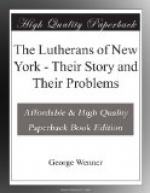What a contrast between this picture and that of our church at the beginning of the nineteenth century! Then two moribund congregations were feebly holding the fort. One of these soon surrendered, “on account of the present embarrassment of finances.” Now a compact army had already been assembled, while new races and languages were beginning to reinforce our ranks. Even the English contingent, which had so long maintained an unequal fight, was securely entrenched in four boroughs with seventeen congregations on its roll.
At this writing, in May, 1918, we number in Greater New York 160 churches with an enrollment of sixty thousand communicant members. At the close of the nineteenth century, in 1898, we had 90 churches with 43,691 communicants. The rate of increase in twenty years was 35 per cent., not very large but sufficiently so to awaken favorable comment from Dr. Laidlaw, an expert observer of church conditions in this city. In 1904, in an article in “Federation,” on “Oldest New York,” he wrote as follows:
“There are now over fifty Christian bodies in this city, and “Oldest New York’s” history shows the fatuity of expecting that the heterogeneous population of the present city will all worship in the same way within the lifetime of its youngest religious worker. Man’s thoughts have not been God’s thoughts, nor man’s ways God’s ways, in the mingling of races and religions on this island. The Lutheranism that so sorely struggled for a foothold in the early days is now the second Protestant communion in numbers, and its recent increment throughout Greater New York, contributed to by German, Scandinavian, Finnish and many English Lutheran churches, has exceeded that of any other Protestant body.”
The causes which contributed to our progress in the latter part of the nineteenth century were still effective. The consolidation of Greater New York, bringing together into one metropolis the scattered boroughs, marked the advent of a Greater Lutheran Church in New York. The bridges and the subways, the telephone and the Catskill Aqueduct, public works of unprecedented magnitude, were among the material foundations of the new growth of our churches.
We were beginning to reap in the second and third generations the fruits of the vast immigration of the nineteenth century.
A new era began for the use of the English language. There had been a demand for English services as early as 1750, but in the eighteenth and the greater part of the nineteenth centuries it had not been met. Fifty years ago, with its two churches, and even twenty-five years ago with four churches, English was a forlorn hope. The advance began in the last decade of the 19th century when twelve English churches were organized. In 1900 there were seventeeen English churches on the roll. Since then 32 have been added, five in Bronx, fifteen in Brooklyn, eleven in Queens, one in Richmond. Besides these forty-nine churches in which the English language is used exclusively, almost all of the so-called foreign churches use English to a greater or less extent as the needs of the people may require.




